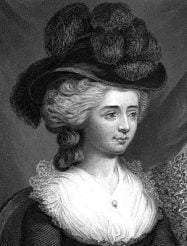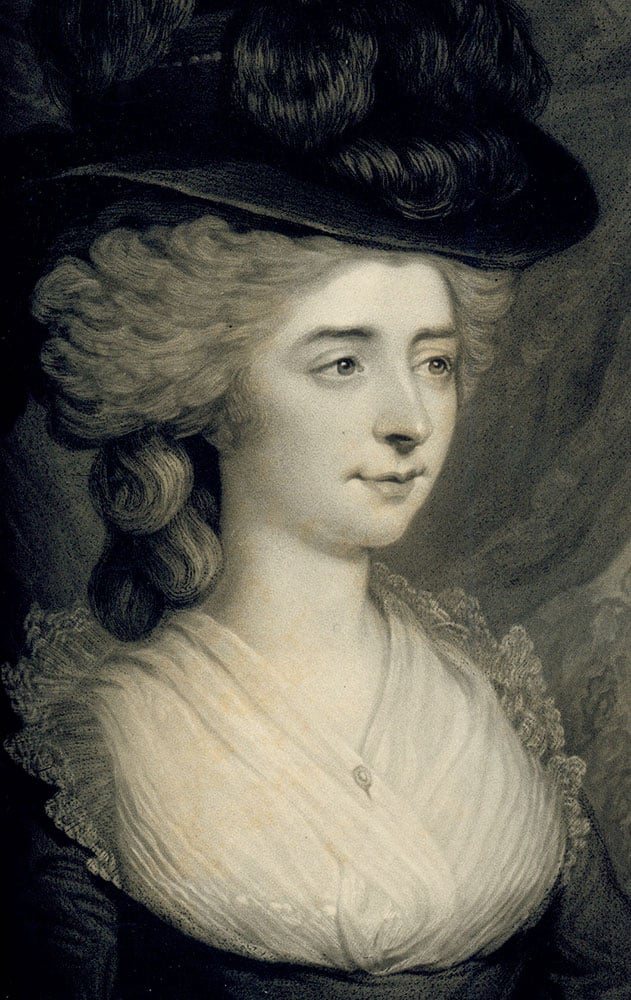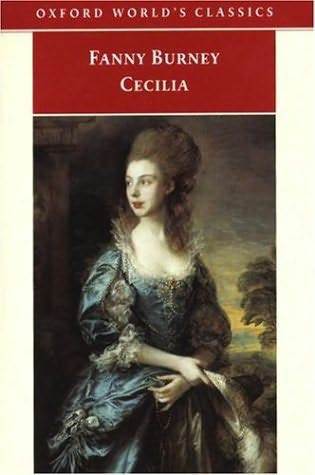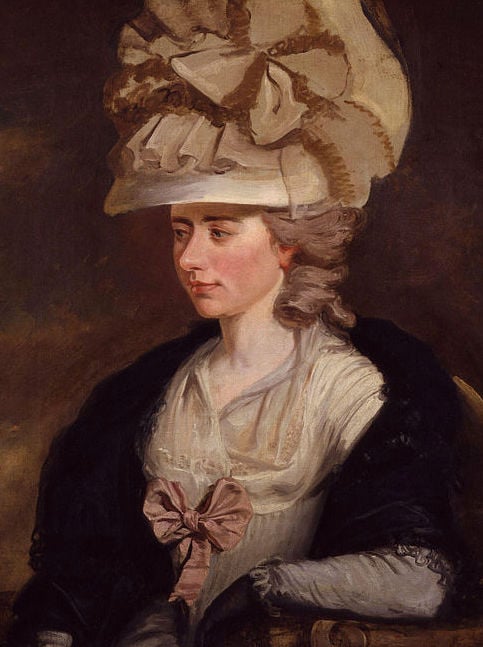Fanny Burney, British Novelist, Diarist, and Playwright
By Nava Atlas | On February 24, 2020 | Updated November 28, 2023 | Comments (0)

Fanny Burney (June 13, 1752 – January 6, 1840), born Frances Burney, was a British novelist, diarist, and playwright best remembered for her first novel, Evelina (1778).
Born in Lynn Regis, now known as King’s Lynn, her father, Dr. Charles Burney, was a musician of note. Her mother, Esther Sleepe Burney, died when Fanny was ten, and this marked the time when she began writing in earnest.
Fanny’s literary output included four novels eight plays, a biography, and some twenty-five volumes of journals and letters. She was an influence on novelists of manner and satire who came a bit later, notably, Jane Austen and William Makepeace Thackeray.
Themes and literary reputation
Fanny’s fictional work touched on the lives of the English aristocracy, subtly (and sometimes not so subtly) satirizing their pretensions. She also delved into issues of women’s place in society.
Evelina and Cecelia were especially popular in their time, but her plays were not performed. Her father feared that his daughter’s reputation would be damaged. The one play that was performed wasn’t well-received, and closed after one performance.
It was considered scandalous for a woman to write and publish, and the fact that Fanny was admired rather than reviled for being a novelist was an exception.
Fanny Burney’s reputation as a novelist declined after her death. Critics and biographers gravitated to her posthumous diaries as a more fascinating source on life in the eighteenth century, though in Fanny’s case, a privileged one.
Contemporary scholars have taken a renewed interest in her work, especially when it addresses the issues and struggles in the lives of women, and as a critique of social mores of the time.
. . . . . . . . . . .

. . . . . . . . . . .
Austin Dobson’s View of Fanny Burney’s life and work
The following brief biography of Fanny Burney’s life and work was published in The Brooklyn Daily Eagle, January 2, 1904, contributed to that publication by Austin Dobson upon the publication of an edition he edited titled The Diary and Letters of Madame D’Arblay (Fanny Burney’s eventual married title). It’s presented here with minor edits, though leaving the rather old-fashioned language intact.
Fanny Burney, an Eighteenth-Century Novelist Whose Work is Almost Forgotten Today
It’s doubtful if many readers today, even those who consider themselves fairly well versed in the history of British literature, could name offhand the author of Evelina. And yet in her day, Fanny Burney was one of the distinguished names in literary England, considered one of the brilliant novelists of the period.
Frances Burney was the daughter of a well-known musician and composer of the middle period of the eighteenth century, a man who was widely known and who held a prominent place in the musical world of the time. Charles Burney was the son of a portrait painter. The artistic strain showed itself in Charles’ taste for music.
His career was successful, and he even wrote a History of Music which was well received. It’s apparent, then, that Fanny had a literary and artistic background for her own development.
Fanny was born at King’s Lynn, where her father lived, engaged in his profession. In 1760 Burney removed to London, where his wife died shortly after. A good portion of Fanny’s girlhood was passed under the care of a stepmother, who seems to have done her whole duty by her.
Charles Burney was intimate with the artistic and literary circles of the capital; his children were reared in an atmosphere of culture and good taste. Fanny has been described as a demure and reserved little person, but full of humor and life when in the comfort of the domestic circle.
Becoming a diarist, growing into young womanhood
When Fanny was twelve, she began keeping a diary, which she prefaced with a whimsical introduction, “Addressed to a Certain Nobody.”
This record, to which she confided her innermost thoughts and opinions, her preferences and likings, her accounts and characterizations of the people she met, as well as her daily personal and family history, was kept up for years.
Aside from its quaint comments and self-revealing qualities, the diary is interesting in showing something of the young woman’s intellectual life, training, and aspirations. That she was an omnivorous reader of the literature of the time is apparent from the list of books she records.
She wrote of going to see Oliver Goldsmith’s new play, She Stoops to Conquer, in 1773 and describes it as “laughable and comic” but says that all diversions are insipid to her except the opera.
As she came into young womanhood she was busily engaged as her father’s secretary in assisting him in the preparation of his History of Music, a work that engaged his attention for several years, and which was regarded at the time as an important work. Fanny’s diary, which was steadily kept up, is especially interesting for the glimpses it gives of the literary celebrities of the time.
During her girlhood days, and because of her passion for writing, Fanny Burney had written a complete work of fiction which she had titled The History of Caroline Evelyn. But she burned the manuscript later and all that’s known about it is what she herself told.
A secret first novel
Just when she began working on Evelina, her first and greatest novel, is not clear from the record, but evidently, she had been at work on it for some time prior to 1776 when she first began to think of publishing. For fear that her handwriting might be recognized, she copied it out in a feigned hand.
It was written as an epistolary novel, that is, in the form of letters, a style that was popular at the time. Fanny’s only confidants were her sister and her eldest brother, James. The publisher was not aware of the identity of the author and his letters were directed to a “Mr. Grafton.” James posed as the book’s author.
The novel finally appeared in 1778, a period when, according to the literary critic Mr. Dobson, English fiction seemed to be suffering from “a kind of sleeping sickness.” A level of mediocrity prevailed in fiction writing.
The great masters who had followed Samuel Richardson’s success with Pamela (1740) were gone — as was Richardson himself. Henry Fielding, whose last novel, Amelia, appeared in 1751, was still read, and both Laurence Stern’s Tristram Shandy and The Vicar of Wakefield had been a considerable time before the public.
. . . . . . . . .

Illustration by Hugh Thompson from a later edition of Evelina
. . . . . . . . .
The author’s true identity emerges
Evelina: Or, The History of a Young Lady’s Entrance into the World came forth, almost unheralded, in the early part of 1778. The secret of authorship was well kept, the book made steady progress, and in two or three months, it began to gain serious attention.
It wasn’t until June of that year that Dr. Burney, the author’s father, read the book. He had read reviews of it without realizing that the author was his daughter. For a woman, and one so young, at that, to publish a novel was quite a radical act, and Fanny feared her beloved father’s reaction.
However, he was impressed with the novel and pleased by the favorable reactions to it by the public and critics, once he realized that it was by his daughter. He was happy for the recognition and praise that Fanny was receiving.
Fanny’s joy was complete when Dr. (Samuel) Johnson gave it the stamp of his hearty approval. She received from the publisher thirty pounds sterling for the novel. Its success made her an esteemed figure in London literary society.
. . . . . . . . .

. . . . . . . . .
A second novel — Cecelia
In 1782, she published her second novel, Cecelia, or the Memoirs of an Heiress, and received 250 pounds for the copyright.
The story of a beautiful, smart young woman, Cecelia Beverly, the novel presents a marriage plot, albeit a somewhat unusual one. The book was well-received, though some critics thought it was a bit weighed down by the author’s awareness that she was writing for an audience — not just for herself as she had done with Evelina.
At thirty years of age, Fanny had, with two published novels, achieved a measure of success as a novelist that attracted the attention of Queen Caroline and King George III. They brought her into the court with an appointment in the royal household as “dresser” to the queen from 1786 to 1790.
The post interfered with her literary work, and after Cecelia, she wrote little that had an element of permanency about it.
It was at the end of 1792 that she met Alexandre D’Arbley, a French artillery officer and refugee, whom she married. The union was a happy one, and after the end of the French Revolution, she lived with her husband in France until the downfall of Napoleon. They had one son, Alexander, born in 1794.
. . . . . . . . .

Frances d’Arblay (Fanny Burney) by Edward Francisco Burney
. . . . . . . . .
Later years
Remarkably, Fanny had a mastectomy in 1810 — without anesthesia. She created the first detailed account of this type of operation, having been awake for its entirety. It hasn’t been established whether she had breast cancer or some other sort of disease of the breast tissue.
Along with her husband and son, she returned to England and lived in Bath until General D’Arbley died there in 1818.
Fanny’s last novel, The Wanderer (1814) was a work of incisive social criticism, but it wasn’t met with enthusiasm by her reading public, and wasn’t reprinted after its first edition. Fanny published Memoirs of Charles Burney in three volumes in 1832. She had remained close with her father until his death.
At one point, she moved to London to be closer to her son while he studied at University. Alexandre, who died in 1837, predeceased her. Fanny Burney died in Bath in 1840; she, her husband, and son are buried in a family plot.
. . . . . . . . . .

. . . . . . . . . .
Fanny Burney’s legacy
Fanny Burney’s novels included Evelina, Cecelia, Camilla, and The Wanderer. In addition, she wrote eight dramatic pieces, a tragedy and a comedy, all of which have been forgotten. Her Diaries and Letters was published about two years after her death.
It is often accepted that Fanny Burney’s legacy as a novelist rest on Evelina and Cecelia. A critic of note wrote that he doubts “if the piety of the enthusiast could ever revive — or rather, create — the slightest interest in The Wanderer, or that any but the fanatics of the out-of-date, or the student of manners, could struggle through Camilla.
Evelina marked a definite deviation in the progress of the English national fiction. Leaving Fielding’s breezy and bustling highway, leaving the analytical hothouse of Richardson, it carries the novel of manners into domestic life, and prepare the way for Maria Edgeworth and the exquisite parlor pieces of Jane Austen.
More about Fanny Burney
On this site
Novels
- Evelina: Or The History of A Young Lady’s Entrance into the World ( 1778)
- Cecilia: Or, Memoirs of an Heiress (1782)
- Camilla: Or, A Picture of Youth (1796, revised 1802)
- The Wanderer: Or, Female Difficulties (1814)
Journals and letters (selected editions)
- The Early Diary of Frances Burney 1768–1778 (1889)
- The Diary and Letters of Madame D’Arblay, Austin Dobson, ed. (1904)
- The Diary of Fanny Burney, Lewis Gibbs, ed. (1971)
- Dr. Johnson & Fanny Burney, Chauncy Brewster Tinker, ed. (1912)
- The Early Journals and Letters of Fanny Burney, 1768–1786
- The Court Journals and Letters of Frances Burney
- The Journals and Letters of Fanny Burney (Madame D’Arblay) 1791–1840
Plays
- The Witlings (1779)
- Edwy and Elgiva (1790)
- Hubert de Vere (1791)
- The Siege of Pevensey (1791)
- Elberta (1791)
- Love and Fashion (1799)
- The Woman Hater, (1801)
- A Busy Day (1801)
Biography
- Fanny Burney: A Biography by Claire Harman (2001)
More information and sources
- British Library
- Wikipedia
- Reader discussion of Fanny Burney’s books on Goodreads
- Burney Society at McGill University
Read and listen online
Leave a Reply